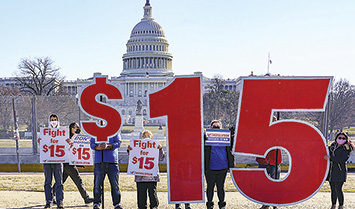
By TIM ROWDEN
Managing Editor
Around 67,000 federal employees received a pay raise on Jan. 30 as the U.S. Department of Labor’s rule raising the minimum wage for federal contractors to $15 took effect.
President Joe Biden signed Executive Order 14026, “Increasing the Minimum Wage for Federal Contractors,” last year establishing $15 per hour as the minimum wage for federal contractors, and instructed the Office of Personnel Management to explore the feasibility of applying that same standard to the federal workforce. In guidance issued last week, said it would approve requests by agencies to increase pay for portions of the Federal Wage System, the federal government’s pay scale for blue collar jobs, to comply with the $15 per hour mandate, according to the Government Executive website.
Of the 67,000 affected employees, more than 56,000 workers are employed by the Defense Department, along with another 9,700 Veterans Affairs Department workers. Other impacted occupations include federal fire fighters, who recently received bonuses and other cash awards to temporarily increase their pay to the equivalent of $15 per hour, as well as custodial staffs across government.
“Raising the contractor minimum wage to $15 per hour [will] improve the lives of hundreds of thousands of American workers and help close pay disparities for women and Black and Latino workers, who are more likely to be employed in the low-wage industries that the federal government contracts out,” said Karla Walter, senior director of employment policy at the Center for American Progress (CAP).
BOOSTS EQUITY
The rule also boosts equity by eliminating the tipped minimum wage for contract workers by 2024, ensuring coverage for disabled workers, and extending contractor minimum wage protections to workers in Puerto Rico and other U.S. territories.
“Corporations receiving billions in government spending must function as model employers,” said Walter. “The final rule is a critical step toward delivering on President Biden’s commitments to raise wages for workers and support a robust economic recovery. It will help ensure that the investments in the Infrastructure Investment and Jobs Act and Build Back Better Act support working Americans from all walks of life.”
PHASES OUT SUBMINIMUM
The rule also calls for phasing out the waiver that has long allowed employers of disabled workers to pay them a subminimum wage.
“This is a huge win for the disability community, which has been fighting for years to phase out 14c — the U.S. government waiver that allows employers to pay subminimum wages. The current average pay for disabled workers is $3.34 per hour, trapping many below the poverty line,” said Mia Ives-Ruble, director of the Disability Justice Initiative at CAP.
“In 2019, 25.9 percent of disabled people lived in poverty compared with 11.4 percent of non-disabled people,” Ives-Rublee said. “Ensuring pay equity for disabled people is an important step toward providing equal rights to the one-in-four Americans who are disabled and will also boost the economy.”


